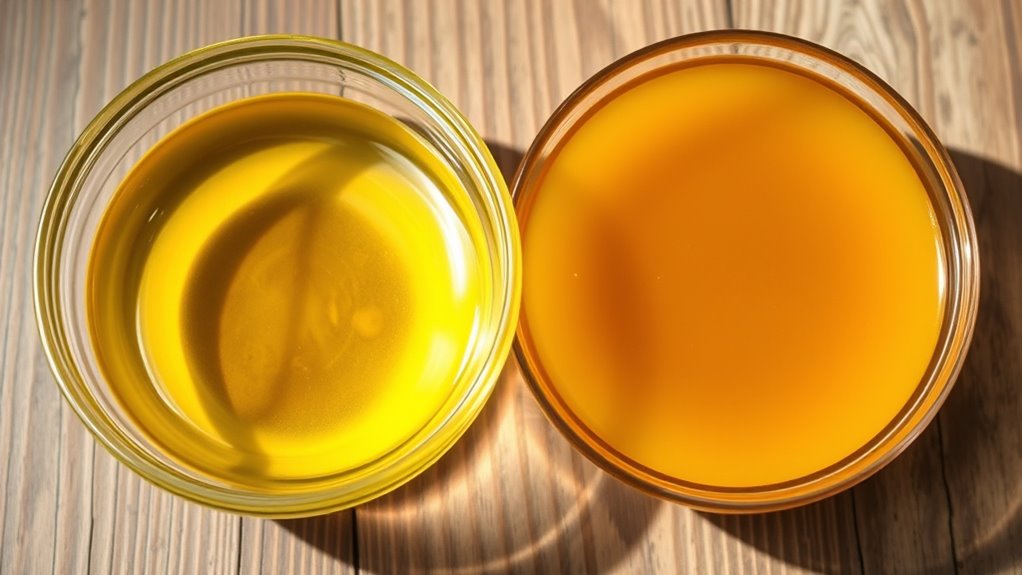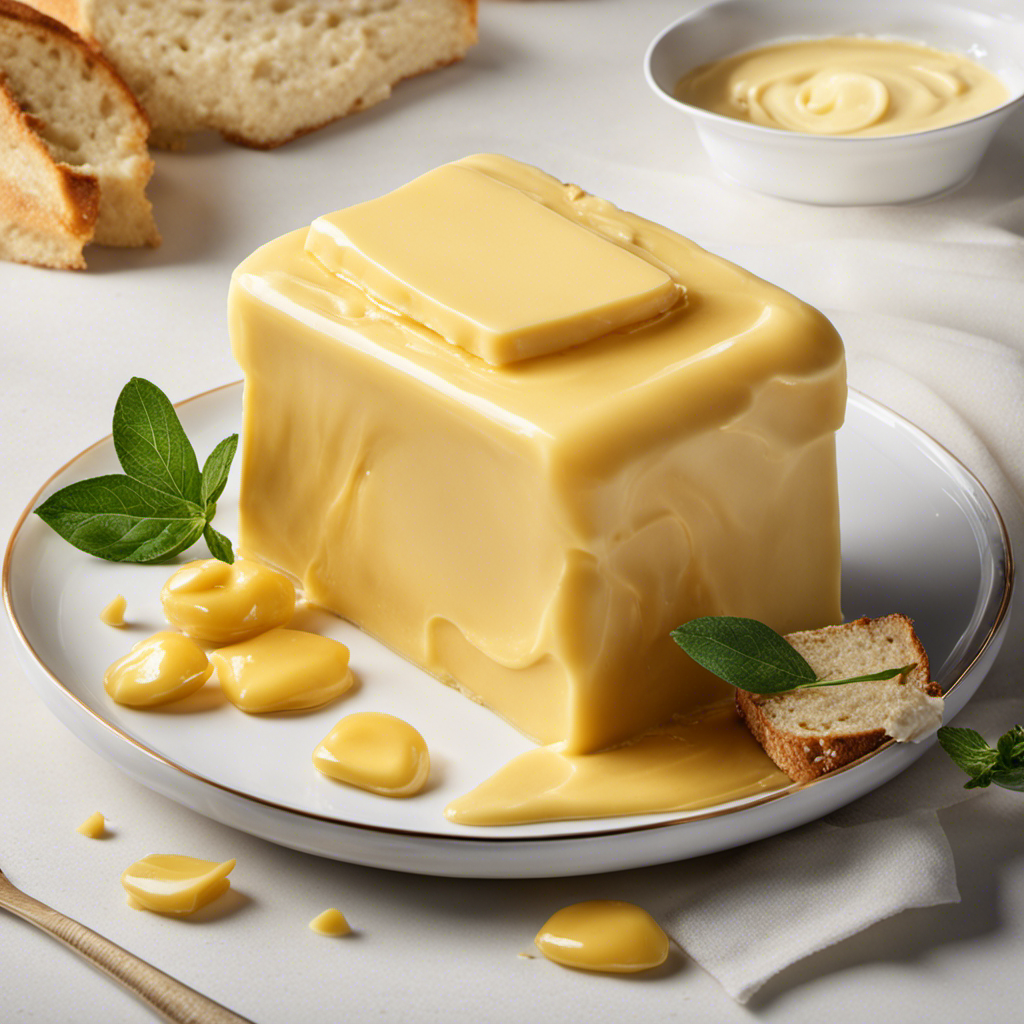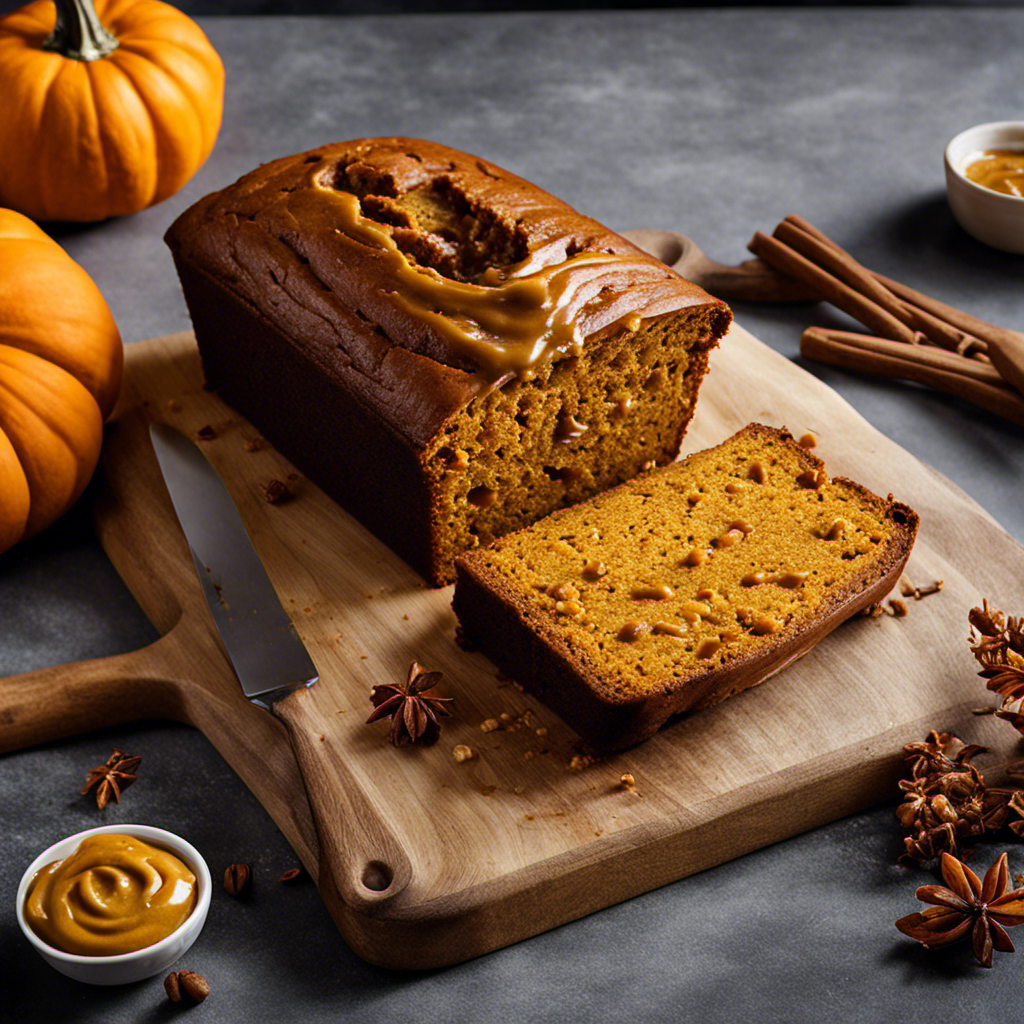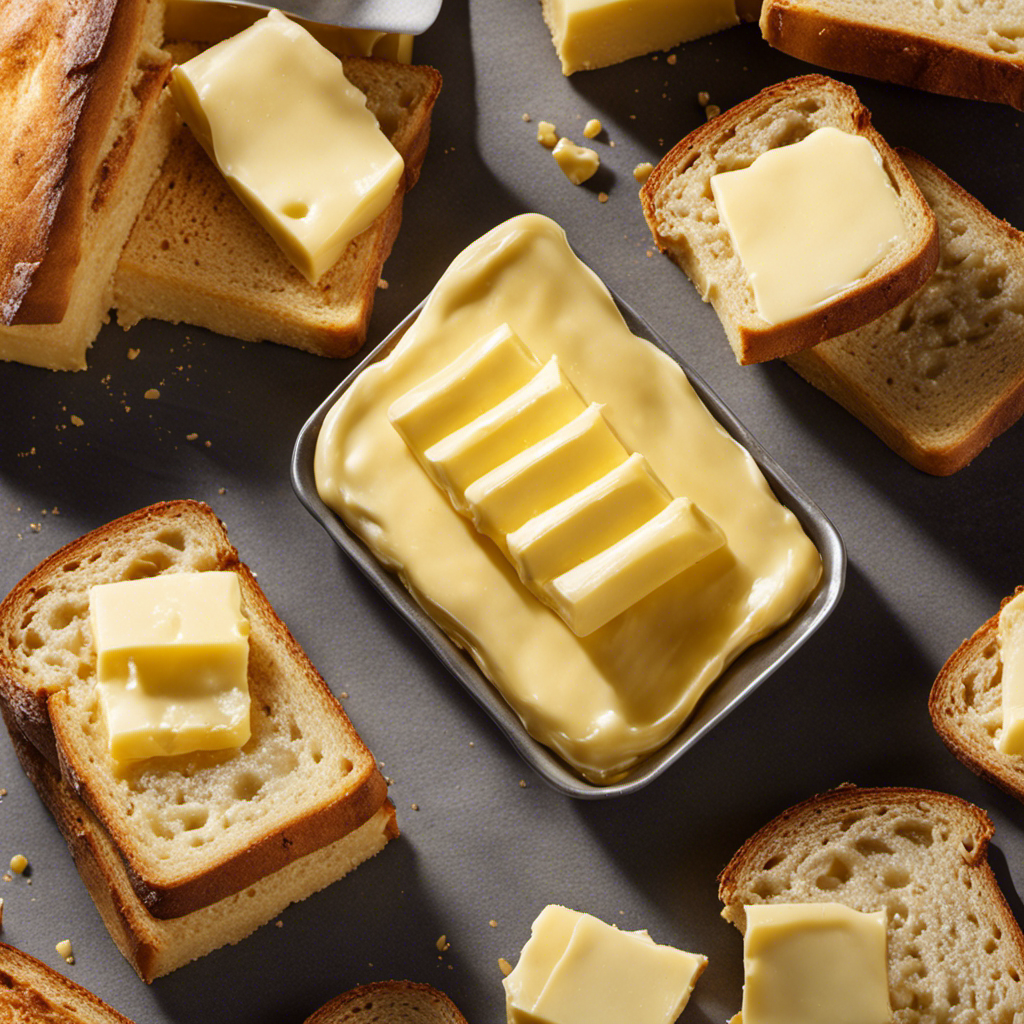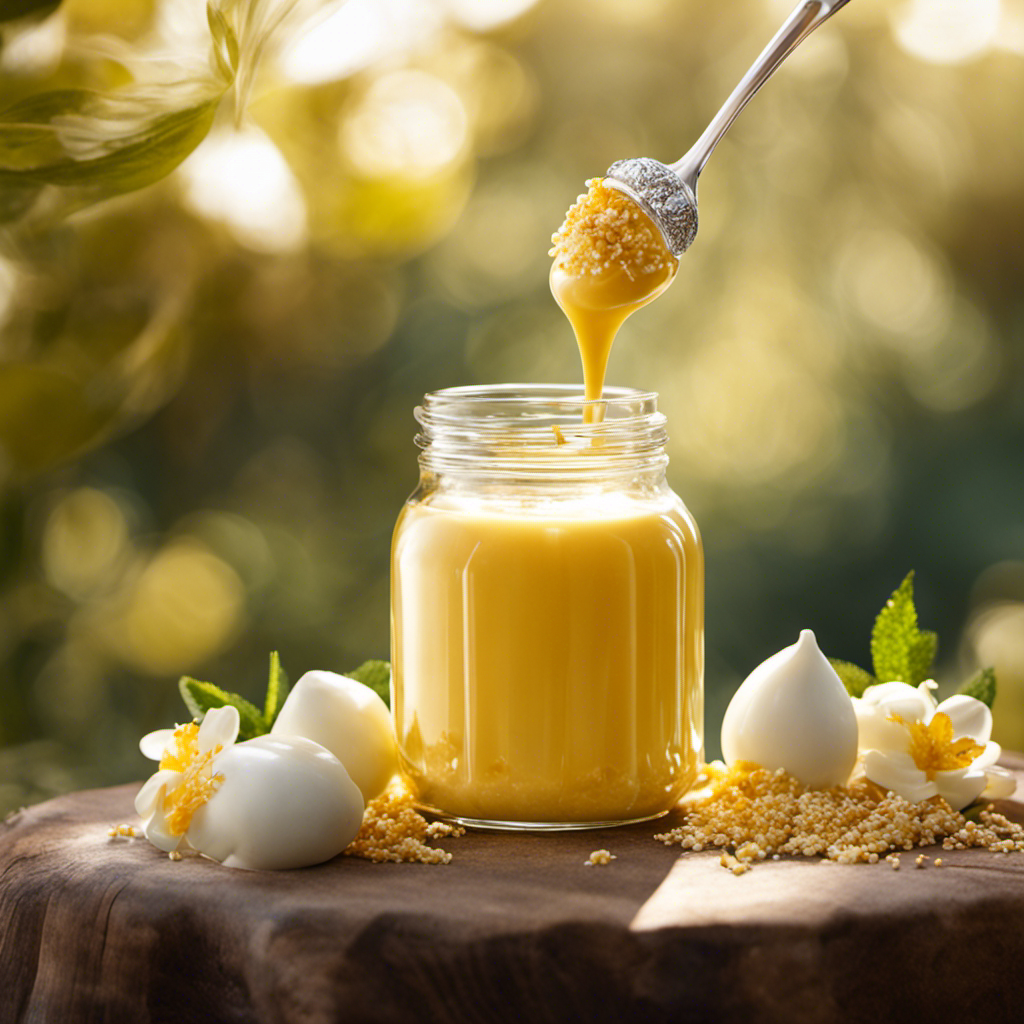Clarified butter is made by quickly melting butter and removing milk solids, resulting in a mild, smooth fat with a softer texture and shorter shelf life. Ghee involves simmering butter longer to caramelize the solids, creating a richer, nuttier flavor, a firmer, granulated texture, and a longer shelf life. These differences influence their culinary uses and health benefits. To discover how these variations can impact your cooking, explore the details below.
Key Takeaways
- Clarified butter is quickly strained to remove milk solids, while ghee is simmered longer, caramelizing solids for a richer flavor.
- Ghee has a deeper, nutty taste and aroma due to extended simmering, unlike the milder clarified butter.
- Clarified butter is softer and more spreadable, whereas ghee is firmer with a granular, crumbly texture.
- Ghee contains more vitamins and antioxidants, with minimal lactose and casein, making it suitable for dairy-sensitive diets.
- Ghee has a longer shelf life than clarified butter, which requires refrigeration and lasts 1-2 months.
The Production Process of Clarified Butter and Ghee

The production processes of clarified butter and ghee both start with melting butter to separate its solid components from the liquid fat. In dairy processing, traditional methods are often used to guarantee authenticity and preserve flavor. You heat the butter gently, allowing the water to evaporate and milk solids to settle or float to the top. For clarified butter, you strain out the milk solids quickly, leaving behind clear, liquid fat. Ghee undergoes a longer simmer, which caramelizes the milk solids, giving it a richer flavor. This slow, traditional approach enhances the quality of both products. Whether you’re making clarified butter or ghee, the key is controlling temperature and timing to assure proper separation and to maintain the integrity of the final product. Temperature control is essential for achieving the desired characteristics in both products.
Differences in Flavor and Aroma
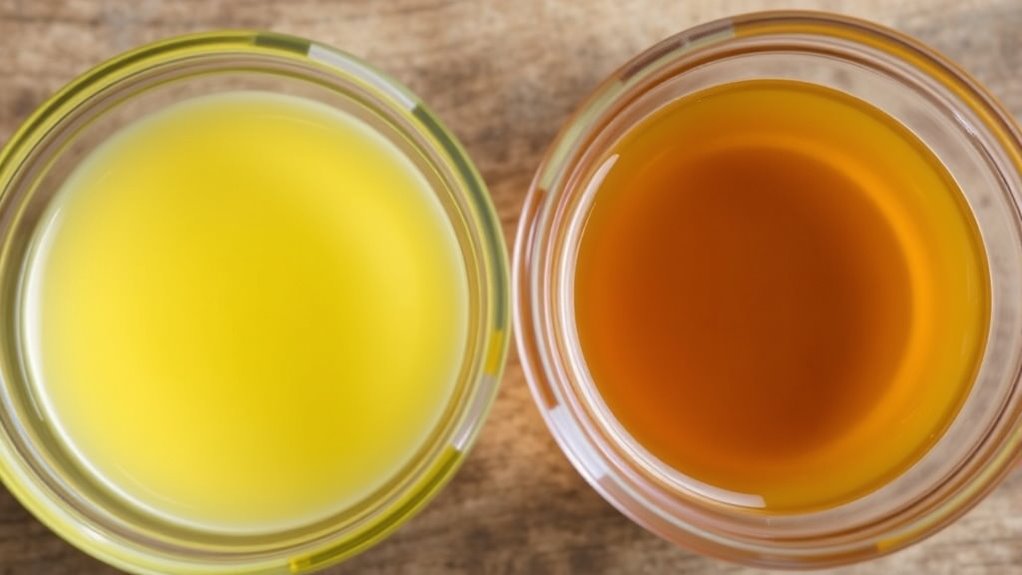
You’ll notice that ghee often has a richer, nuttier flavor compared to the milder taste of clarified butter. The aroma of ghee tends to be more roasted and intense, while clarified butter remains more delicate. These subtle differences can influence how each adds depth to your dishes. Additionally, the role of Merkle trees in blockchain technology highlights how data integrity and security are maintained, much like how the distinct qualities of ghee and clarified butter serve different culinary purposes.
Subtle Flavor Variations
While both clarified butter and ghee share a rich, buttery aroma, subtle differences in their flavors can influence your culinary choices. Clarified butter offers a clean, slightly sweet, and creamy taste that enhances delicate dishes like sauces and baked goods. Ghee, on the other hand, has a more pronounced nutty and toasted flavor, adding depth to curries and grilled foods. These flavor profiles impact how you select ingredients for specific recipes, as ghee’s robust taste can stand up to bold spices, whereas clarified butter provides a smoother, more neutral base. Recognizing these subtle flavor variations helps you create dishes with the perfect balance of taste and aroma. Additionally, understanding the flavor and aroma differences can guide you in choosing the right fat for different cooking techniques, ensuring optimal results.
Aromatic Differences
Both clarified butter and ghee share a rich, buttery aroma, but their scent profiles differ noticeably once you take a closer whiff. The aromatic nuances reveal subtle distinctions that impact their culinary uses.
- Clarified butter offers a delicate, slightly sweet aroma, emphasizing its fresh dairy origin.
- Ghee’s scent profile is deeper, with toasted, nutty notes from the caramelization process.
- The aromatic nuances of ghee often include hints of roasted grains or spices, adding complexity.
- These scent differences influence how each fat enhances dishes, with ghee providing a richer, more robust aroma.
- Recognizing these aromatic differences allows cooks to select the ideal fat to enhance flavor and create more authentic dishes.
Variations in Texture and Appearance
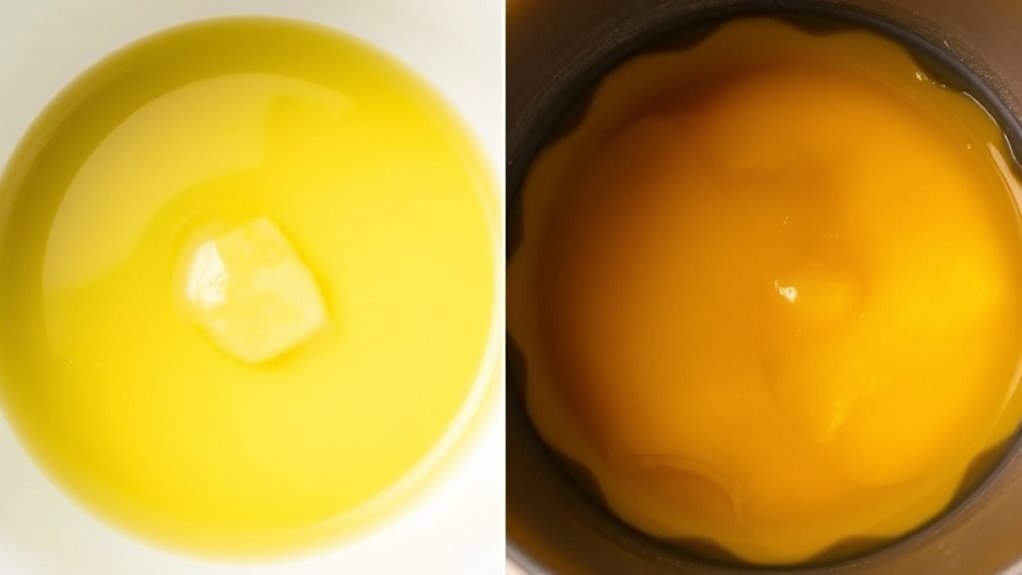
Although clarified butter and ghee are similar in composition, their textures and appearances can differ noticeably. In a texture comparison, clarified butter tends to be softer and more spreadable at room temperature, with a smooth, almost creamy feel. Ghee, on the other hand, is usually firmer and more granular, often resembling a dense, slightly crumbly consistency. When it comes to appearance distinctions, clarified butter has a pale yellow color and a glossy surface, reflecting its liquid state when warm. Ghee appears more golden or amber-hued, with a slightly grainy or flaky surface when cooled. These visual and tactile differences are key to identifying each, especially in cooking or food preparation. Recognizing these variations helps you use the right product for your culinary needs, especially since texture and appearance are important indicators in identifying quality and suitability for various dishes.
Shelf Life and Storage Characteristics
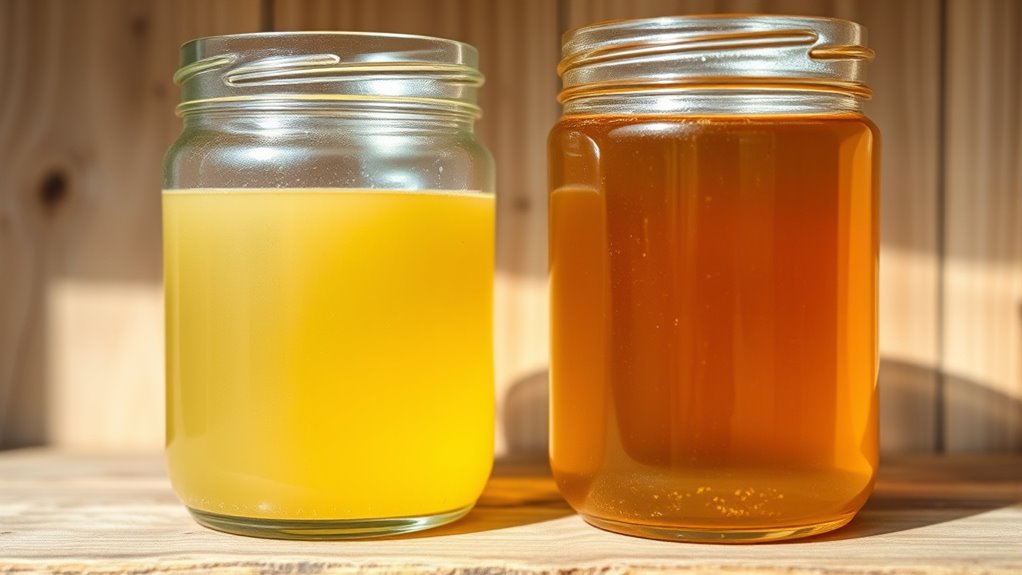
Ghee generally has a longer shelf life than clarified butter because its removal of moisture and milk solids creates a more stable fat. This enhances its shelf stability and allows for a longer storage duration without spoiling. Proper storage is key to maintaining quality. To maximize shelf life, keep ghee in an airtight container, away from direct sunlight and heat. Here are some important points:
- Airtight containers prevent oxidation and contamination.
- Store in a cool, dark place to slow spoilage.
- Ghee can last up to a year at room temperature if stored properly.
- Clarified butter, containing residual moisture, has a shorter shelf stability and should be refrigerated for 1-2 months.
- Understanding the storage characteristics of these fats helps optimize their shelf life and quality over time.
Following these guidelines ensures your clarified fats stay fresh and safe to use longer.
Nutritional Content and Health Benefits
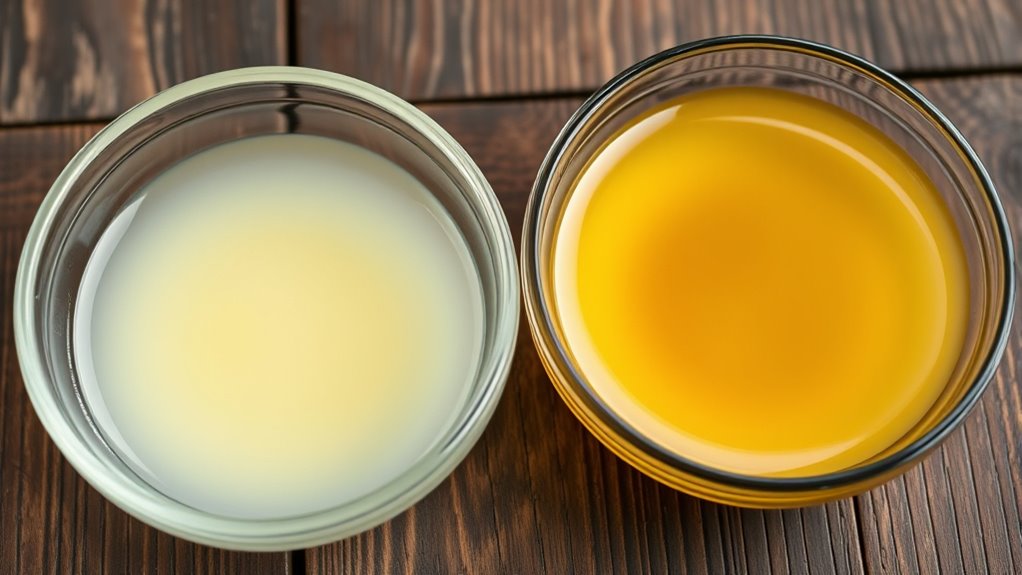
You’ll find that ghee and clarified butter differ in their nutrient content, which can impact your health. Ghee often contains more vitamins and antioxidants due to its processing, potentially offering digestive and immune support. Understanding these differences helps you choose the better option for your nutrition and wellness goals. Additionally, personal debt forgiveness bills can influence financial decisions, highlighting the importance of staying informed about legislative changes that may affect your overall wellbeing.
Nutrient Composition Differences
Clarified butter and ghee differ particularly in their nutrient profiles, which can impact their health benefits. Both are rich in dairy fat, but their nutrient content varies due to processing methods. Here are key differences:
- Ghee typically has a higher concentration of fat-soluble vitamins like A, D, E, and K, enhancing its nutrient profile.
- Clarified butter retains more milk solids, meaning it contains small amounts of proteins and lactose.
- Ghee usually contains fewer residual dairy components, making it more suitable for those with lactose intolerance.
- The nutrient composition influences health benefits, with ghee often valued for its antioxidant content and clarified butter for its dairy fat quality.
- Vetted – Halloween Product Reviews highlight that different products may offer varying nutritional qualities based on their preparation.
Digestive and Immune Benefits
Have you ever wondered how clarified butter and ghee can support your digestion and immune system? These fats have been used for centuries in traditional uses that emphasize their health benefits. Ghee, in particular, holds cultural significance in many societies, believed to aid digestion and strengthen immunity. The healthy fats in ghee help stimulate stomach acids, improving nutrient absorption and reducing digestive discomfort. Its antioxidants, like butyrate, support gut health and reduce inflammation. Additionally, ghee contains fat-soluble vitamins that boost immune function. Incorporating ghee into your diet aligns with its traditional uses as a healing food, promoting overall wellness. The integration of automation technologies in food production has also contributed to maintaining the quality and safety of ghee, ensuring it remains a healthy choice. By understanding its cultural significance, you can appreciate how these fats not only enhance flavor but also contribute to your digestive and immune health.
Culinary Uses and Best Applications
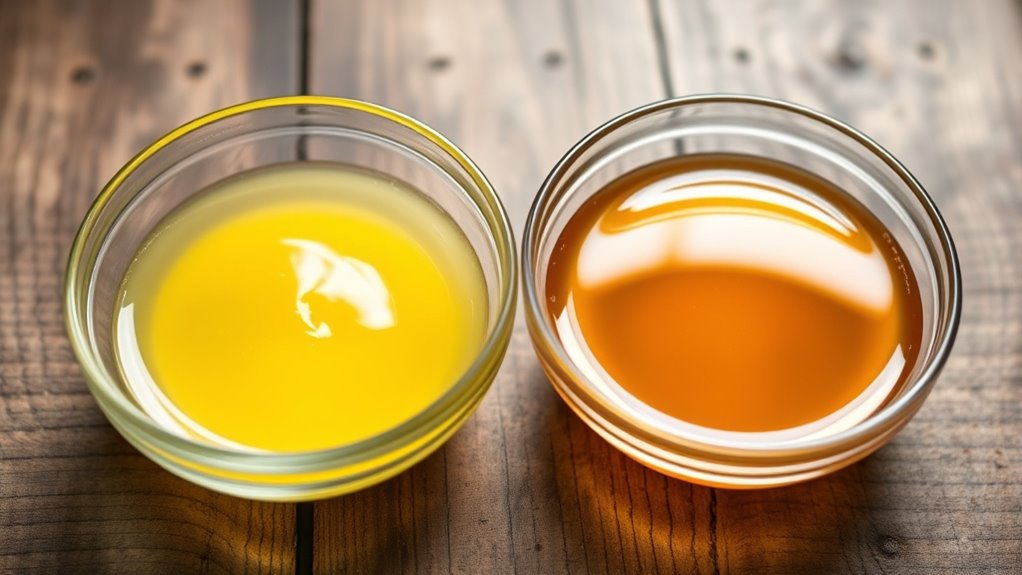
Wondering which fat to choose for your cooking? Clarified butter and ghee both shine in the kitchen, but their best uses differ. Here are four ways to incorporate them effectively:
Choose clarified butter for high-heat cooking and ghee for baking to enhance flavor and health benefits.
- Use clarified butter for high-heat cooking like sautéing or frying, thanks to its higher smoke point.
- Choose ghee for baking applications, as its rich flavor enhances cookies, cakes, and bread.
- Consider dietary considerations—ghee contains minimal lactose and casein, making it suitable for some dairy-sensitive diets.
- Use clarified butter in sauces or drizzling over dishes for added richness without overpowering flavors. Whether you prefer clarified butter or ghee, understanding their culinary applications helps you make the best choice for your recipes and health needs.
Frequently Asked Questions
Is Ghee Suitable for All Dietary Restrictions?
Ghee is generally appropriate for many diets, but if you’re lactose intolerant, you should know it contains trace amounts of lactose and casein, which might cause issues. Vegans and those avoiding animal products should opt for plant-based alternatives like coconut or vegan butter. Always check labels to verify the product meets your dietary needs, and consult with a healthcare professional if you’re unsure.
Can Clarified Butter Be Made at Home Easily?
Making clarified butter at home is as easy as pie! With simple preparation, you just melt butter gently, then skim off the foam and strain out the solids. This way, you create a rich, golden liquid that’s perfect for cooking. If you’re after homemade alternatives, this method keeps it straightforward and budget-friendly, giving you fresh clarified butter without any fuss. It’s a kitchen hack that’s just waiting for you to try!
Which Is More Expensive, Ghee or Clarified Butter?
You’ll find that ghee tends to be more expensive than clarified butter because of its longer cooking process and the ingredient costs involved. Ghee’s richer flavor and traditional preparation add to its higher pricing differences. Clarified butter is usually cheaper, since it requires less processing and fewer ingredients. So, if you’re watching your budget, clarified butter is generally the more affordable choice.
Does the Method of Production Affect Health Benefits?
The processing methods and additive content directly impact the health benefits of clarified butter and ghee. If the production involves minimal processing and no additives, you’ll likely get a purer product with more natural nutrients. Conversely, heavily processed versions with added preservatives or flavorings may reduce health benefits. So, always check how they’re made, as cleaner methods generally mean better health advantages for you.
Are There Regional Variations in Ghee and Clarified Butter?
Think of ghee and clarified butter as cultural messengers carrying regional flavors across borders. You’ll find variations rooted in local traditions—Indian ghee often has a nutty aroma, while Middle Eastern versions may include spices. These differences reflect diverse cultural traditions, shaping unique tastes and uses. So, your choice depends on the culinary story you want to tell, with each region adding its own flavor to this golden ingredient.
Conclusion
Now that you know the astonishing differences between clarified butter and ghee, you’re armed with the ultimate culinary secret weapon. Whether you’re elevating your dishes or boosting your health, this knowledge transforms everyday cooking into an epic adventure. Imagine creating flavors so divine, your taste buds will dance in pure ecstasy! Don’t settle for ordinary—embrace the extraordinary power of clarified butter and ghee and turn every meal into a legendary masterpiece!
